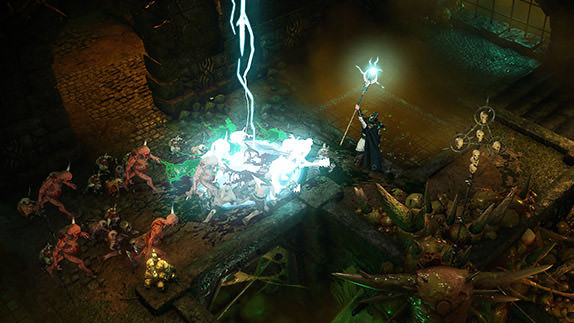Strike Suit Zero: Director’s Cut Review

 By Kevin Mitchell | May 20, 2014
By Kevin Mitchell | May 20, 2014
Space combat games were a mainstay on my go-to list growing up, thanks to the likes of FreeSpace and Homeworld. After the disappearance of the genre, Born Ready Games has been a main component in its revival, not only on PC but on consoles as well. Strike Suit Zero: Director's Cut lets players feel like a badass in a transforming spaceship (think Macross), allowing you to take on multiple small agile fighters and stand toe-to-toe with massive carriers and cruisers with guns larger than your entire ship.
The release of Strike Suit Zero: Director's Cut marks the first time the series (which includes the original Strike Suit Zero and Strike Suit Infinity) has been released on PlayStation 4 or Xbox One. The game was initially released over a year ago, but since then, Born Ready Games has been making major strides to improve the game through patches and community feedback. The Director's Cut includes all of the improvements from the past year and packages everything together along with the optional DLC from the PC release.
After being crowdfunded on Kickstarter in late 2012, the initial release of the game in early 2013 was shaky, to say the least. A few months later, Born Ready released a wave-based version of the game that I thoroughly enjoyed more than the story-driven Strike Suit Zero. It wasn't until the developers fixed the major issues with the original game that I gave it another chance. Console gamers won't have to worry, as the Director's Cut can be considered the definitive version of the game. Frustrating checkpoints that were far and few between in missions are now much more frequent, and you'll be piloting the strike suit sooner.
As the story unfolds, humanity takes to the stars, spreading out swiftly and colonizing countless worlds. The colonists, wanting their independence, engage the United Nations of Earth in all-out war. Across a little over a dozen missions (thirteen to be exact), you control a silent Earth pilot at the tail end of the war. Thankfully, the artificial intelligence (known as Control) that tags along is constantly chatting throughout the missions. Mission objectives evolve as time goes on, having you dogfighting against colonist pilots, protecting capital ships from incoming torpedoes, and even eliminating those same capital ships. Battlefields feature dozens of enemies, with many that aren't directly related to objectives, making it easy to get lost in the skirmish. I've spent countless missions chasing down the wrong set of fighters, only to fail because I failed to protect an objective.
Since there haven't been any space combat games on consoles recently, the controls may take some time to get used to. I recommend playing on a lower difficulty for the first couple of missions, which is exactly what I did, even though I played the game previously on PC. Learning when to use both analog sticks simultaneously will take some practice, as well as remembering the button placement on the DS4. Accelerating and braking are controlled using L1 and L2, with your weaponry controlled using the right set of shoulder buttons. Various face buttons will cycle through targets, and the directional pad can swap in and out different weapons.
What makes Strike Suit Zero stand out from the rest of the space combat genre is the shifting between the suit's two combat modes. Pursuit mode controls just like any other ship you've used in space combat titles. It's the better of the two modes when it comes to dogfighting and maneuverability. Transforming your ship in real-time, strike mode should be used when the situation calls for raw firepower. Sacrificing agility, you'll still be able to evade incoming missiles; the strike suit can turn large groups of enemy fighters into a debris field in a matter of seconds. All of the extra firepower comes with a price, however, as using strike mode will cost flux energy, which can only be regained by killing enemies. Once mastered, you'll find yourself transforming back and forth between the two different modes throughout the majority of the missions.
Most missions feature objectives centering on escorting, requiring you to keep an eye on friendly units at all times. The stylish nebulas and spacescapes set the mood for the encounters but disappoint, as most are static in nature. Improved textures from the initial release highlight the additional work that has gone into the game, but the ship models still feel flat, lacking in details. Neon-colored trails flow behind ships before dissipating into the darkness. Composed by Paul Ruskay (you may remember him from Homeworld), the musical score has an Eastern feel with plenty of vocalized chants of mysterious-sounding phrases echoing in the background of the instrumental beat.
Simply Put
Strike Suit Zero: Director's Cut fixes many of the glaring issues from the initial release of the game, giving console and PC gamers the definitive edition. The controls will take some getting used to, and in the heat of intense dogfighting, it is easy to hit the wrong button or lose your target. Word of advice: don't crash into capital ships.
Note: Strike Suit Zero: Director’s Cut was reviewed on PlayStation 4. A digital copy of the game was provided by the publisher/developer.




